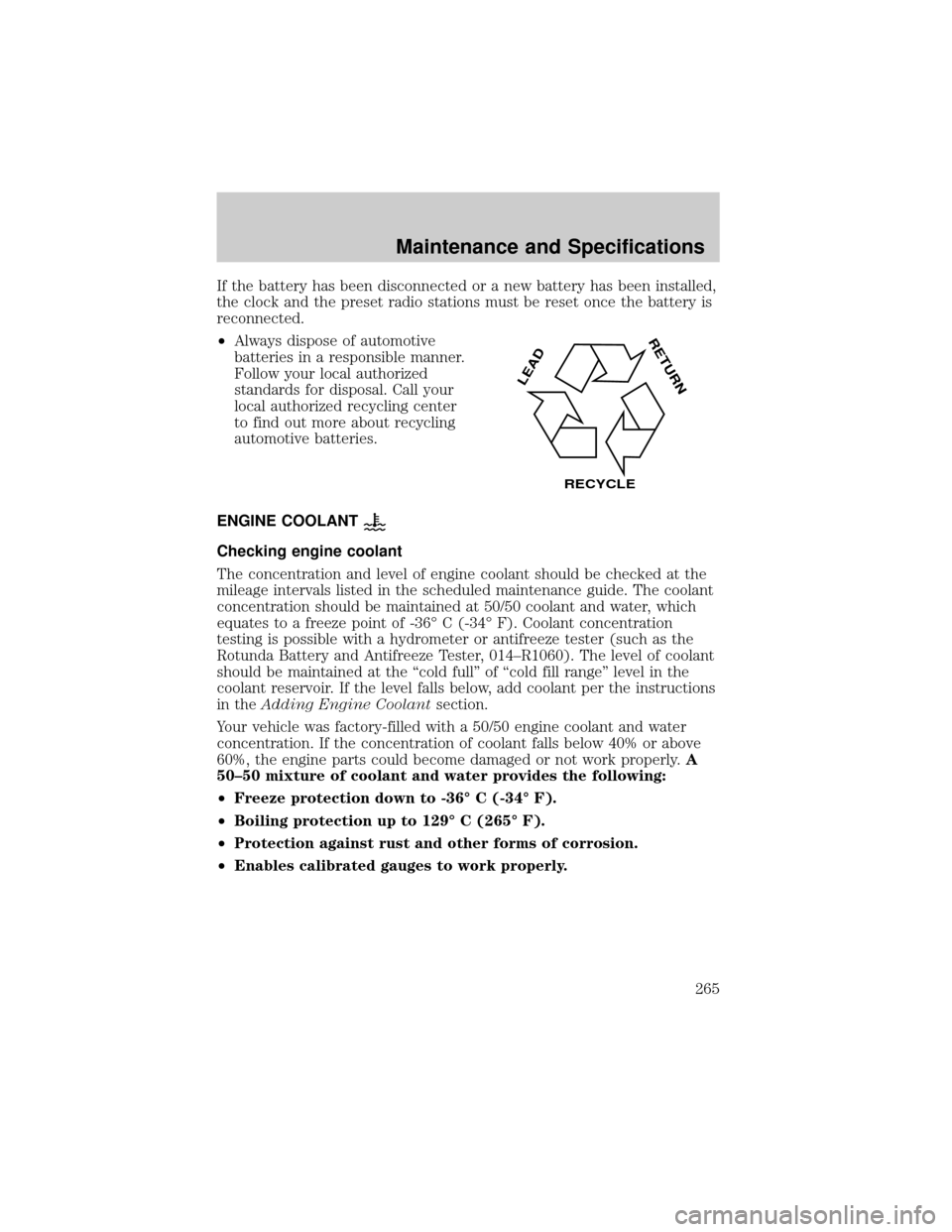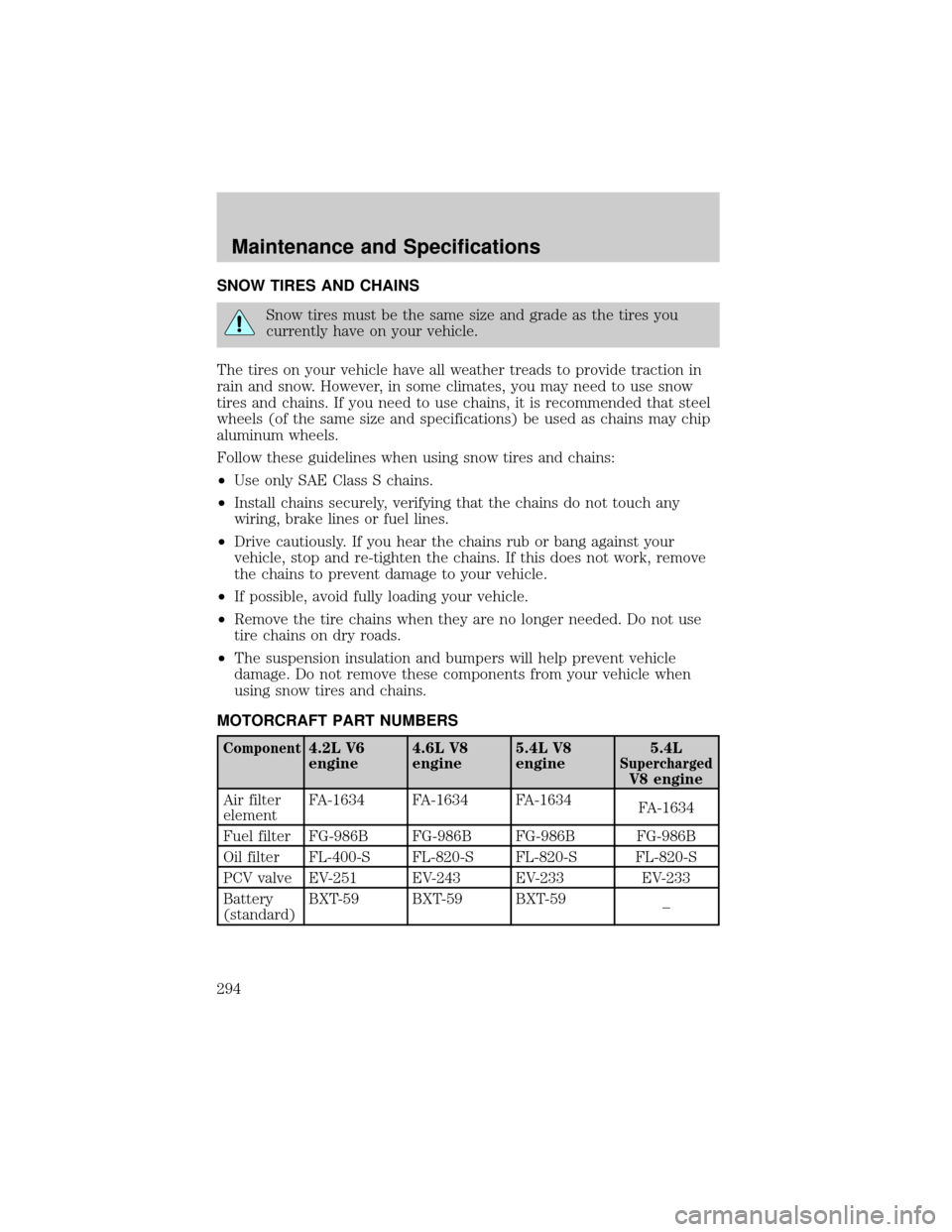2002 FORD F150 battery
[x] Cancel search: batteryPage 264 of 320

When lifting a plastic-cased battery, excessive pressure on the
end walls could cause acid to flow through the vent caps,
resulting in personal injury and/or damage to the vehicle or battery.
Lift the battery with a battery carrier or with your hands on opposite
corners.
Keep batteries out of reach of children. Batteries contain sulfuric
acid. Avoid contact with skin, eyes or clothing. Shield your eyes
when working near the battery to protect against possible splashing of
acid solution. In case of acid contact with skin or eyes, flush
immediately with water for a minimum of 15 minutes and get prompt
medical attention. If acid is swallowed, call a physician immediately.
Battery posts, terminals and related accessories contain lead and
lead compounds.Wash hands after handling.
Because your vehicle's engine is also electronically controlled by a
computer, some control conditions are maintained by power from the
battery. When the battery is disconnected or a new battery is installed,
the engine must relearn its idle and fuel trim strategy for optimum
driveability and performance. To begin this process:
1. With the vehicle at a complete stop, set the parking brake.
2. Put the gearshift in P (Park) (automatic transmission) or the neutral
position (manual transmission), turn off all accessories and start the
engine.
3. Run the engine until it reaches normal operating temperature.
4. Allow the engine to idle for at least one minute.
5. Turn the A/C on and allow the engine to idle for at least one minute.
6. Drive the vehicle to complete the relearning process.
²The vehicle may need to be driven 16 km (10 miles) or more to
relearn the idle and fuel trim strategy.
²If you do not allow the engine to relearn its idle trim, the idle
quality of your vehicle may be adversely affected until the idle
trim is eventually relearned.
Maintenance and Specifications
264
Page 265 of 320

If the battery has been disconnected or a new battery has been installed,
the clock and the preset radio stations must be reset once the battery is
reconnected.
²Always dispose of automotive
batteries in a responsible manner.
Follow your local authorized
standards for disposal. Call your
local authorized recycling center
to find out more about recycling
automotive batteries.
ENGINE COOLANT
Checking engine coolant
The concentration and level of engine coolant should be checked at the
mileage intervals listed in the scheduled maintenance guide. The coolant
concentration should be maintained at 50/50 coolant and water, which
equates to a freeze point of -36É C (-34É F). Coolant concentration
testing is possible with a hydrometer or antifreeze tester (such as the
Rotunda Battery and Antifreeze Tester, 014±R1060). The level of coolant
should be maintained at the ªcold fullº of ªcold fill rangeº level in the
coolant reservoir. If the level falls below, add coolant per the instructions
in theAdding Engine Coolantsection.
Your vehicle was factory-filled with a 50/50 engine coolant and water
concentration. If the concentration of coolant falls below 40% or above
60%, the engine parts could become damaged or not work properly.A
50±50 mixture of coolant and water provides the following:
²Freeze protection down to -36É C (-34É F).
²Boiling protection up to 129É C (265É F).
²Protection against rust and other forms of corrosion.
²Enables calibrated gauges to work properly.
LEAD
RETURN
RECYCLE
Maintenance and Specifications
265
Page 281 of 320

Do not park, idle, or drive your vehicle in dry grass or other dry
ground cover. The emission system heats up the engine
compartment and exhaust system, which can start a fire.
Illumination of the ªService Engine Soonº light, charging system warning
light or the temperature warning light, fluid leaks, strange odors, smoke
or loss of engine power, could indicate that the emission control system
is not working properly.
Exhaust leaks may result in entry of harmful and potentially
lethal fumes into the passenger compartment.
Do not make any unauthorized changes to your vehicle or engine. By
law, vehicle owners and anyone who manufactures, repairs, services,
sells, leases, trades vehicles, or supervises a fleet of vehicles are not
permitted to intentionally remove an emission control device or prevent
it from working. Information about your vehicle's emission system is on
the Vehicle Emission Control Information Decal located on or near the
engine. This decal identifies engine displacement and gives some tune up
specifications.
Please consult yourWarranty Guidefor complete emission warranty
information.
Readiness for Inspection/Maintenance (I/M) testing
In some localities, it may be a legal requirement to pass an I/M test of
the on-board diagnostics system. If your ªService Engine Soonº light is
on, refer to the description in theWarning lights and chimessection of
theInstrument Clusterchapter. Your vehicle may not pass the I/M test
with the ªService Engine Soonº light on.
If the vehicle's powertrain system or its battery has just been serviced,
the on-board diagnostics system is reset to a ªnot ready for I/M testº
condition. To ready the on-board diagnostics system for I/M testing, a
minimum of 30 minutes of city and highway driving is necessary as
described below:
²First, at least 10 minutes of driving on an expressway or highway.
²Next, at least 20 minutes driving in stop-and-go, city-type traffic with
at least four idle periods.
Allow the vehicle to sit for at least eight hours without starting the
engine. Then, start the engine and complete the above driving cycle. The
Maintenance and Specifications
281
Page 294 of 320

SNOW TIRES AND CHAINS
Snow tires must be the same size and grade as the tires you
currently have on your vehicle.
The tires on your vehicle have all weather treads to provide traction in
rain and snow. However, in some climates, you may need to use snow
tires and chains. If you need to use chains, it is recommended that steel
wheels (of the same size and specifications) be used as chains may chip
aluminum wheels.
Follow these guidelines when using snow tires and chains:
²Use only SAE Class S chains.
²Install chains securely, verifying that the chains do not touch any
wiring, brake lines or fuel lines.
²Drive cautiously. If you hear the chains rub or bang against your
vehicle, stop and re-tighten the chains. If this does not work, remove
the chains to prevent damage to your vehicle.
²If possible, avoid fully loading your vehicle.
²Remove the tire chains when they are no longer needed. Do not use
tire chains on dry roads.
²The suspension insulation and bumpers will help prevent vehicle
damage. Do not remove these components from your vehicle when
using snow tires and chains.
MOTORCRAFT PART NUMBERS
Component4.2L V6
engine4.6L V8
engine5.4L V8
engine5.4LSuperchargedV8 engine
Air filter
elementFA-1634 FA-1634 FA-1634
FA-1634
Fuel filter FG-986B FG-986B FG-986B FG-986B
Oil filter FL-400-S FL-820-S FL-820-S FL-820-S
PCV valve EV-251 EV-243 EV-233 EV-233
Battery
(standard)BXT-59 BXT-59 BXT-59
±
Maintenance and Specifications
294
Page 295 of 320

Component4.2L V6
engine4.6L V8
engine5.4L V8
engine5.4LSuperchargedV8 engine
Battery
(heavy
duty)BXT-65-650 BXT-65-650 BXT-65-650
BXT-65-650
Spark
plugs-
platinum
1
AGSF-34EE2AWSF-32P AGSF-22W AGSF-12E or
AGSF-12FM1
2, 3
1
Refer to Vehicle Emissions Control Information (VECI) decal for spark
plug gap information.
2If a spark plug is removed for inspection and replaced, it must be
reinstalled in the same cylinder. If a spark plug needs to be replaced, use
only spark plugs with the service number suffix letter as shown above.
3Use only AGSF-12FM1 spark plugs for replacement.
REFILL CAPACITIES
Fluid Ford Part
NameApplication Capacity
Brake fluid
and clutch
fluidMotorcraft
High
Performance
DOT 3 Motor
Vehicle Brake
FluidAll Fill to line or step
(for clutch) on
reservoir
Engine
coolant
1Motorcraft
Premium
Engine
Coolant
(green-colored)orMotorcraft
Premium
Gold Engine
Coolant
(yellow-colored)
4.2L V6 engine with
1 row radiator19.0L (20.1 quarts)
4.2L V6 engine with
2 row radiator20.4L (21.6 quarts)
4.6L V8 engine with
1 row radiator19.5L (20.6 quarts)
4.6L V8 engine with
2 row radiator21.9L (23.1 quarts)
5.4L V8 engine with
1 row radiator22.6L (23.9 quarts)
5.4L V8 engine with
2 row radiator24.1L (25.5 quarts)
Maintenance and Specifications
295
Page 310 of 320

Power sliding rear window
Remote start system
Tire step
Travel equipment
Cargo cage (SuperCrew only)
Bed mount bike carrier
Bed tent
Daytime running lights (DRL)
Fog lights
Hitch mount bike carrier
Inside mirror with compass display
Inside mirror with compass and temperature display
Off road lights
Outside signal mirror (available only with power mirrors)
Pickup box rails
Retractable bed hooks
Running boards (molded, diamond plate, tubular and stirrup step)
Seatback organizer
Speed control
Towing mirrors
Trailer hitch (Class III)
Trailer hitch bars and balls
Trailer hitch wiring adaptor
Trailer swivel hitch
Protection and appearance equipment
Air bag anti-theft locks
Battery warmer/blanket
Bed mat/bedliner tailgate covers
Bed mats
Bedliners
Accessories
310
Page 313 of 320

A
Accessory delay ..........................86
Air bag supplemental
restraint system ........................145
and child safety seats ............147
description ..............................145
disposal ....................................149
driver air bag ..........................147
indicator light ...................13, 149
operation .................................147
passenger air bag ...................147
passenger deactivation
switch ......................................150
Air cleaner filter ...............289, 294
Air conditioning ..........................59
manual heating and air
conditioning system .................55
Ambulance packages ....................7
Antifreeze
(see Engine coolant) ................265
Anti-lock brake system
(see Brakes) ......................170±171
Anti-theft system
warning light .............................15
Armrests ....................................130
Automatic transmission ............175
driving an automatic
overdrive .................................176
fluid, adding ............................284
fluid, checking ........................284
fluid, refill capacities ..............295
fluid, specification ..................301
Auxiliary power point ...........82, 84
Axle
lubricant
specifications ..................299, 301refill capacities ........................295
traction lok ..............................174
B
Battery .......................................263
acid, treating emergencies .....263
charging system
warning light .............................13
jumping a disabled battery ....226
maintenance-free ....................263
replacement,
specifications ..........................294
servicing ..................................263
voltage gauge ............................18
Bed extender ..............................99
Belt minder ...............................140
Brakes ........................................170
anti-lock ...........................170±171
anti-lock brake system
(ABS) warning light .........12, 171
brake warning light ..................12
fluid, checking and adding ....283
fluid, refill capacities ..............295
fluid, specifications .........299, 301
lubricant
specifications ..................299, 301
parking ....................................172
pedals (see Power
adjustable foot pedals) ............88
shift interlock ..........................175
Break-in period .............................5
C
Capacities for refilling fluids ....295
Cassette tape player ...................36
CD changer .................................49
Certification Label ....................307
Index
313
Page 315 of 320

E
Emergencies, roadside
jump-starting ..........................226
Emission control system ..........280
Engine ................................301±302
check engine/service
engine soon light ......................11
cleaning ...................................244
coolant .....................................265
fail-safe coolant ......................270
idle speed control ...................263
lubrication
specifications ..................299, 301
refill capacities ........................295
service points ..................255±257
starting after a collision .........211
Engine block heater .................169
Engine oil ..................................258
checking and adding ..............258
dipstick ....................................258
filter, specifications ........262, 294
recommendations ...................262
refill capacities ........................295
specifications ..................299, 301
Exhaust fumes ..........................169
F
Fail safe cooling ........................270
Floor mats ...................................97
Fluid capacities .........................295
Foglamps .....................................65
Four-Wheel Drive
vehicles ................................15, 184
description ..............................187
driving off road .......................188
electronic shift ........................187indicator light ...................15, 185
lever operated shift ................185
preparing to drive your
vehicle .....................................174
Fuel ............................................271
calculating fuel economy .......277
cap .....................................12, 273
capacity ...................................295
choosing the right fuel ...........274
comparisons with EPA
fuel economy estimates .........280
detergent in fuel .....................276
filling your vehicle
with fuel ..................271, 273, 277
filter, specifications ........276, 294
fuel pump shut-off switch .....211
gauge .........................................18
improving fuel economy ........277
low fuel warning light ..............13
octane rating ...274±275, 301±302
quality ......................................275
running out of fuel .................276
safety information relating
to automotive fuels ................271
Fuses ..................................213±214
G
Garage door opener ..............79, 93
Gas cap (see Fuel cap) ......12, 273
Gas mileage
(see Fuel economy) .................277
Gauges .........................................16
battery voltage gauge ...............18
engine coolant temperature
gauge .........................................17
engine oil pressure gauge ........17
fuel gauge ..................................18
odometer ...................................19
speedometer .............................18
Index
315